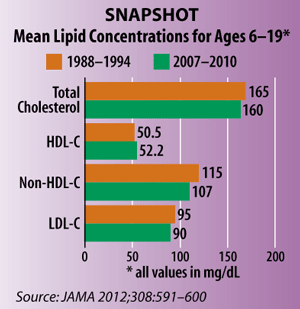Good News in Youth Cholesterol Trends
Mean total cholesterol levels in children and adolescents declined slightly over the past 2 decades, in keeping with a similar trend in adults. The latest findings come from analysis of National Health and Nutrition Examination Survey data during three time periods: 1988–1994, 1999–2002, and 2007–2010.
Overall, 16,116 youths age 6–19 years participated in the nationally representative survey. Centers for Disease Control and Prevention, U.S. Public Health Service, and National Institutes of Health researchers found that mean total cholesterol levels in youths dropped from 165 mg/dL to 160 mg/dL between 1988–1994 and 2007–2010, and that the prevalence of elevated total cholesterol declined from 11.3% to 8.1%. Mean high-density lipoprotein cholesterol (HDL-C) levels also increased significantly over the same period, from 50.5 mg/dL to 52.2 mg/dL, while mean non-HDL-C levels declined significantly, from 115 mg/dL to 107 mg/dL.

The improved lipid levels extended to obese youths, although in some cases the trends in this group were attenuated in comparison to children and adolescents overall. For example, HDL-C increased by a statistically insignificant 1 mg/dL, from 44.2 mg/dL to 45.2 mg/dL. Nevertheless, the overall positive trend in lipid levels along with the increased prevalence in obesity among youth during the study period suggests that the improvement in cholesterol might have been even larger had fewer young people become obese.
Though the findings generally spell good news for American youth, the trends were not all positive. For example, in 2007–2010, more than 20% of children ages 9–11 years had either a low HDL-C or high non-HDL-C level. In addition, Mexican American males did not have increased HDL-C or significant changes in low-density lipoprotein cholesterol or triglycerides.
The researchers speculated on numerous factors that could be behind the favorable trends, including declines in smoking and tobacco smoke exposure among youths, as well as trends in immigration and socioeconomic status.